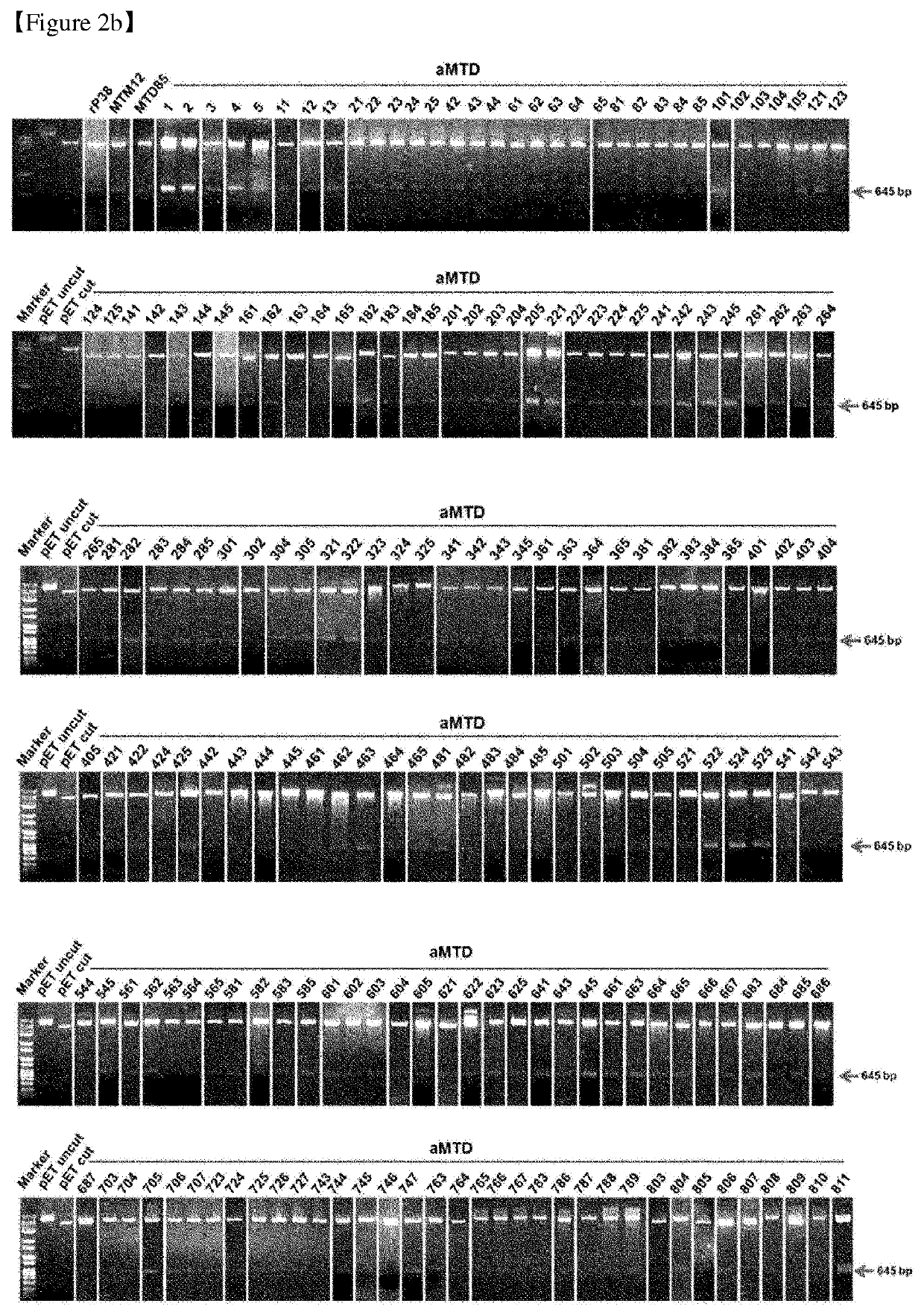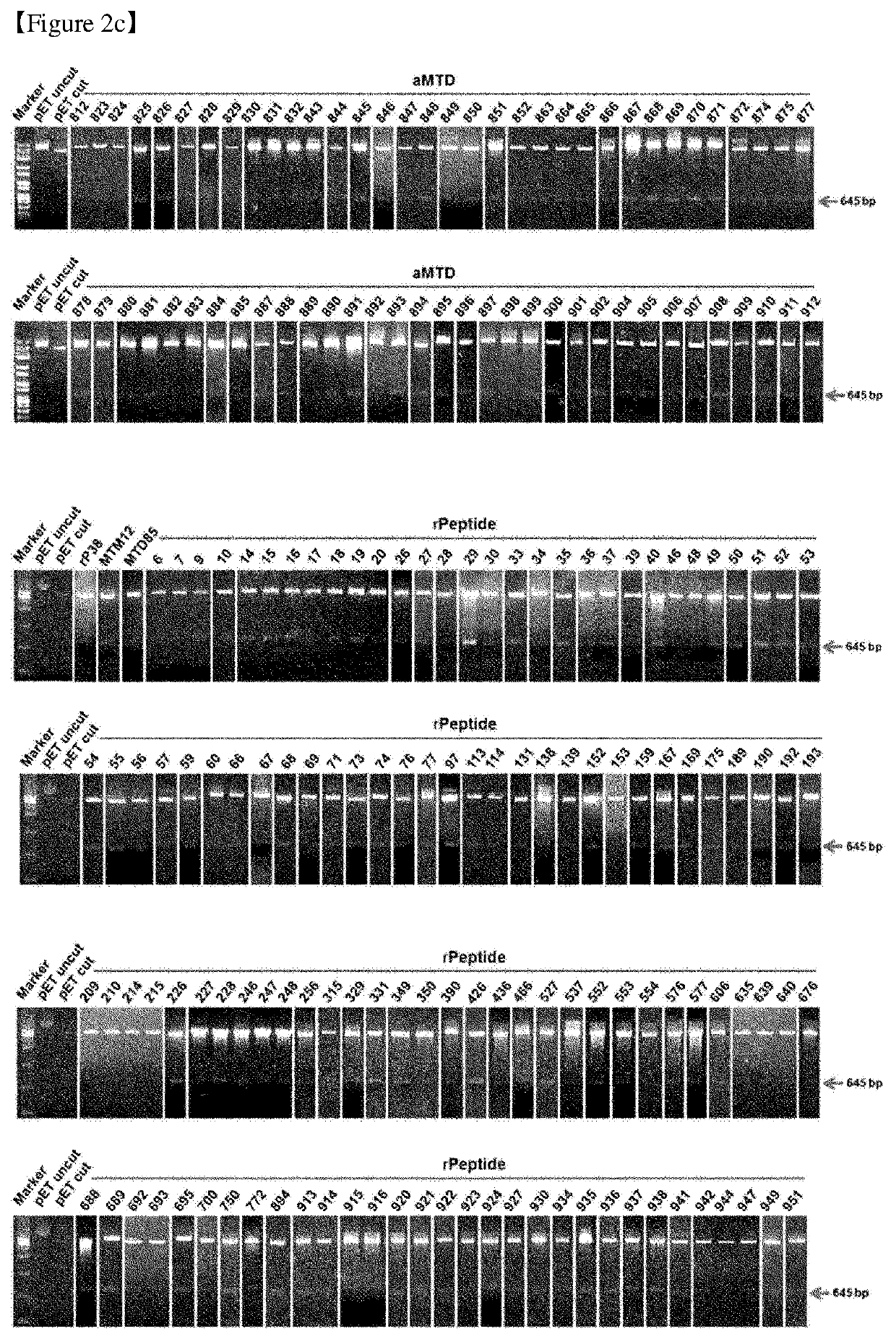Cell-permeable (CP)-Δ SOCS3 recombinant protein and uses thereof
a cell-permeable, recombinant protein technology, applied in the field of improved cell-permeable (cp)truncated socs3 (socs3), can solve problems such as failure of trial
- Summary
- Abstract
- Description
- Claims
- Application Information
AI Technical Summary
Benefits of technology
Problems solved by technology
Method used
Image
Examples
example 1
nt of Novel Advanced Macromolecule Transduction Domain (aMTD)
[0392]H-regions of signal sequences (HRSP)-derived CPPs (MTS / MTM and MTD) do not have a common sequence, a sequence motif, and / or a common structural homologous feature. In this invention, the aim is to develop improved hydrophobic CPPs formatted in the common sequence and structural motif that satisfy newly determined ‘critical factors’ to have a ‘common function.’ to facilitate protein translocation across the plasma membrane with similar mechanism to the analyzed CPPs.
[0393]The structural motif as follows:
[0394]
[0395]Here, X(s) independently refer to Alanine (A). Valine (V), Leucine (L) or Isoleucine (I); and Proline (P) can be positioned in one of U(s) (either 5′, 6′, 7′ or 8′). The remaining U(s) are independently composed of A, V, L or I, P at the 12′ is Proline.
[0396]In Table 9, universal common sequence / structural motif is provided as follows. The amino acid length of the peptides in this invention ranges from 9 to...
example 2
ion of Expression Vectors for Recombinant Proteins Fused to aMTDs
[0397]Our newly developed technology has enabled us to expand the method for making cell-permeable recombinant proteins. The expression vectors were designed for histidine-tagged CRA proteins fused with aMTDs or rPeptides. To construct expression vectors for recombinant proteins, polymerase chain reaction (PCR) had been devised to amplify each designed aMTD or rPeptide fused to CRA.
[0398]The PCR reactions (100 ng genomic DNA, 10 pmol each primer, each 0.2 mM dNTP mixture, 1× reaction buffer and 2.5 U Pfu(+) DNA polymerase (Doctor protein, Korea) was digested on the restriction enzyme site between Nde 1 (5′) and Sal 1 (3′) involving 35 cycles of denaturation (95° C.), annealing (62° C.), and extension (72° C.) for 30 seconds each. For the last extension cycle, the PCR reactions remained for 5 minutes at 72° C. Then, they were cloned into the site of pET-28a(+) vectors (Novagen. Madison. Wis. USA). DNA ligation was perfo...
example 3
Expression, Purification and Preparation of Recombinant Proteins Fused to aMTDs and rPeptides
[0399]To express recombinant proteins, pET-28a(+) vectors for the expression of CRA proteins fused to a negative control [rPeptide 38 (rP38)], reference hydrophobic CPPs (MTM12 and MTD85) and aMTDs were transformed in E. coli BL21 (DE3) strains. Cells were grown at 37° C. in LB medium containing kanamycin (50 μg / ml) with a vigorous shaking and induced at OD600=0.6 by adding 0.7 mM IPTG (Biopure) for 2 hours at 37′C. Induced recombinant proteins were loaded on 15% SDS-PAGE gel and stained with Coomassie Brilliant Blue (InstantBlue, Expedeon, Novexin, UK) (FIG. 3).
[0400]The E. coli cultures were harvested by centrifugation at 5,000×rpm for 10 minutes, and the supernatant was discarded. The pellet was re-suspended in the lysis buffer (50 mM NaH2PO4, 10 mM Imidazol, 300 mM NaCl. pH 8.0). The cell lysates were sonicated on ice using a sonicator (Sonics and Materials. Inc., Newtown, Conn., USA) eq...
PUM
| Property | Measurement | Unit |
|---|---|---|
| chemical | aaaaa | aaaaa |
Abstract
Description
Claims
Application Information
 Login to View More
Login to View More - R&D
- Intellectual Property
- Life Sciences
- Materials
- Tech Scout
- Unparalleled Data Quality
- Higher Quality Content
- 60% Fewer Hallucinations
Browse by: Latest US Patents, China's latest patents, Technical Efficacy Thesaurus, Application Domain, Technology Topic, Popular Technical Reports.
© 2025 PatSnap. All rights reserved.Legal|Privacy policy|Modern Slavery Act Transparency Statement|Sitemap|About US| Contact US: help@patsnap.com



